Look and Feel
Model Suitability (out of 10):
Attributes (out of 10):
Introduction
What paper should I use to fold a particular model?
 It may be the most asked question in origami, yet no one has a complete and total answer to it. Truth be told, we will not attempt to determine a perfect solution to this question. Instead, we will try to build a foundation of knowledge, adding a few bricks based on our common experience and a few more based on the help of some colleagues.
It may be the most asked question in origami, yet no one has a complete and total answer to it. Truth be told, we will not attempt to determine a perfect solution to this question. Instead, we will try to build a foundation of knowledge, adding a few bricks based on our common experience and a few more based on the help of some colleagues.
In order to review a sheet of paper, one must first decide what the properties of paper are. Then, through hands-on experience, one can decide their value or grade, from low to high (0 to 10). This grade is not a measure of good or bad as different models require different qualities.
Moreover, a single grade is not enough. There is little point to reviewing Elephant Hide as applied to Miniature Unit Origami, or Foil to a wet fold. One should try to determine what a paper is good for, to be tessellated, or to fold insect models, for example. Only then can the paper be judged. There is no bad paper; there is only the wrong model for the paper.
Every complex model starts with a valley fold, so we'll start there.
The properties
- Thickness - in grams per square meter (GSM). One cannot say that thinner is always better if you plan to wet fold, so there is no good or bad here, just pure information.
- Size - how big can you get it? Smaller sizes can be achieved by cutting it down yourself, so for many, the question is “Is it big enough?”
- Color palette - from narrow (as with Elephant Hide we have fewer than ten options) to wide (100 color sets of Tant paper). The value is as simple as the number of color choices.
- Texture - the look and feel of the surface: smooth, rough, alive, skin-like, shiny, etc. with two subcategories.
- Friction - for the use of Modular origami.
- Transparency - for back-light Tessellations. This is an unvalued parameter.
- Aging - span of life. We would love to know how many years our models will stand firm and colorful. Alas with some papers we do not have a lifetime of experience to judge aging with data. Input from readers will help with this!
- Paper Coloring or colorability Since some papers are the same color on both sides, or come only in white, you may want to get the right color for your model by coloring in. This paragraph describes how the paper behaves when being colored. We will try to answer questions like: "Does it soak through to the other side?" and "Can you get the accurate hue you wanted?" and more.
- PhotogenicToday a lot of us fold for the camera, since more viewers will be able to see the digital version online than the real one! This section describes the way the paper looks in images; with or without flash; appearance of the texture; etc.
Folding properties
- Memory - How well the paper remembers a fold (where aluminum foil gets a value of 10, while a plastic bag gets a 0).
- Forgiveness - the ability to "erase" a fold line, or to reverse it. Onion Skin paper is very hard to reverse fold, while Elephant Hide is very easy. One can even make a fold line disappear with it! Scale will be from 0 to 10.
- Tensile Strength - wear and tear; does it break up when refolded three or four times? Tensile strength is the maximum stress the paper can undergo while being stretched or pulled. While Elephant Hide would score high in this category, Kami would only get a 4. This score may be proportional to the number of times you can fold the paper before it breaks, if we will have the patience to perform that tedious test. The value will range from 0 to 10.
- Bending Resistance - some categories of folding rely on the tension of the paper to hold its shape. Bending resistance relates to the amount of force required to bend the paper. We will try to value that on a range from 0 to 10. Thanks to David Whitbeck, from the O-list, for adding this property!
General properties
- Accessibility - where to buy.
- Bottom line - final score.
Material properties
This is of course an open list; suggestions for additions are more than welcome.
The process
To value a paper in an origami sense, you must fold it. For this project, each paper was examined by two folders. We each folded the same six models out of the following Origami categories:
- Traditional - animals, mostly but not only - it includes all one-sheet, classical 2-D models. The most traditional model is the crane, of course, folded from a 15X15 cm square.
- Action model - There are three main action moves: a pull, a push, and flexing the paper. The following three models were selected to test for each of these action moves:
- Barking Dog by Gadi Vishne: This is a great model for testing the push mechanism, which makes the dog bark.
- Flapping Bird (traditional): We will examine the pull factor of the paper by flapping the wings.
- Jumping Frog (traditional): This model will be used to check the flex factor of the paper, measured with the distance the frog jumps.
- Modular/Unit Origami - all models that are based on tabs and pockets, inserts and locks, and need more than one sheet to be created. Two models were chosen:
- PowerPuff modular, by Ilan Garibi, made from thirty 15X15 cm units.
- Icarus Cube by Dave Mitchell, made from six 5x5 cm units.
- Tessellation - one sheet, repeated pattern. Two models were chosen:
- Pineapple tessellation, by Ilan Garibi, from a 70X70 cm paper, for complex folding and multiple layers.
- Mystery tessellation, by Ilan Garibi, from a 70X70 cm paper, for transparency and surface behavior.
- Complex - insect, ancient dragons, 100 plus stages of folds, entry paper size - 25X25 cm. This model must utilize multiple layer folds and some sinks. We have chosen Satoshi Kamiya's Pegasus folded from two sizes of paper - 25X25 cm (the recommended size) and 35X35 cm.
- 3D models and Wet Folding - wet folded or not, these include intermediate to complex models which have full body and can stand on their feet. We have chosen a Fox Terrier by Francisco Javier Caboblanco (20X20 cm) and Eric Joisel's Rat.
This list is neither final nor closed. There are many additional subcategories that could be added to this list of origami categories, like flowers, jewelry, toys and more. We will allow ourselves to deviate from the proposed list according to the paper's specific needs and characteristics. When relevant to a specific paper type, we will supplement our review with models from all relevant categories, addressing them in the "What is it good for" section.
Review of Elephant Hide (EH)
Made in Germany, by Zanders, it may be crowned as the King of Paper. We tried to get some information about the ingredients of EH and its manufacturing process, but this is privileged information and would not be shared by the manufacture. Its Data Sheet says “Elephant hide is a rugged bookbinding paper with a parchment grain which can be used as a book covering paper or for making certificates. It is impregnated and therefore scratch and abrasion resistant, dirt repellent, can be wiped clean (wet-strength paper), has limited expansion and shrinkage and is not sensitive to acid. In addition, it is tear resistant and wrinkle and fold resistant as well as color-fast and lightfast.” What more could we ask for? It is FSC certified, so you are helping to save forests by buying it. More than that, each sheet is unique as no two sheets are alike.
When this paper was discovered by paperfolders, it became very popular among them. Here are some reasons why:
- Thickness - today EH comes in two weights, 110 GSM and 190 GSM. This review will focus on the 110 GSM only. Although it is a heavy paper (we regard 100 GSM as the border line), it is still easy to fold and handle.
- Sizes - once again, only two options here: 700X1000mm, and A4. There is no square option, since it is not origami-related paper. Of course, one can cut any size and shape from 700X1000, but it is tedious to prepare 60 identical units for a modular model.
- Colors - The palette is very limited - only seven colors are listed on the site of the manufacture today (15 Nov 2010): White, high White, Ivory, light Brown, light Grey, Charcoal, and Black. On Modulor there are ten colors, but out of these ten, the two most colorful ones (Dark Blue and Dark Green) are available only at A4 size. In the past there used to be larger variety of colors, and the author has a personal stock of 14 shades. Among them are red and blue which are no longer produced. It doesn't look like these colors will come back in the future. After checking with the manufacture, there is no plan to widen color options, and they are unaware if any stock of the obsolete colors is currently being held by official distributors. If one would like to place a special order, it can be done in any color, size and weight required, with a minimum order of 5 tons (equal to 64,935 sheets of 700X1000 or 727,273 of A4).

- Paper coloring or colorability: Perfect! Elephant Hide can be colored beautifully with Ecoline Water Color made by Talens. The coloring does not seep through to the back of the paper. When dried there are no waves and the paper is still flat. See the Bull by Stephan Weber, folded and colored by Herman Mariano.
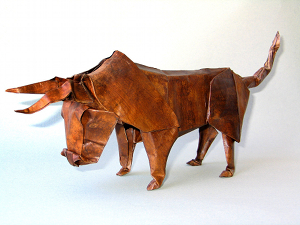
- Texture - smooth, since the paper is laminated; the color is not homogeneous, having a beautiful marbled texture. There is a slight, hard to see difference between the two sides; one of them is a bit more reflective. Every sheet is different. Besides the Black, all colors are optically transparent to some degree. The most transparent colors are the whites and the light brown, both of which can be used to great effect while backlighted. Grey and black are hardly transparent, if at all.
- Photogenic: The camera loves this paper! You can use backlighting to make the texture of the paper especially visible, or use strong, frontal lighting to make it disappear almost completely. The paper almost does not reflect at all. I also use it for the background to get an interesting, but not distracting surface.
- Aging - without acid, and with the special treatment this paper goes through, time progresses slowly with this paper. I have a few models that are two years old, and they still look brand new. The manufacture is proud of this paper's durability. Remember, it is used for book binding which means it is made to last.
- Memory - perfect score here. You make a crease, and it stays, seemingly forever. The creases are sharp, and unfolded creases will create a long bump in the paper, easy to feel by touch. 10 out of 10!
- Forgiveness - Switching between a mountain and a valley fold (or tearing the paper) can be easily performed when folding along the grain of the paper. This procedure can become a bit more difficult when folding against the grain. To err is human, but to forgive - divine. If a crease is folded a mere millimeter from its intended location, one can easily create a new one in the right place, and even uncrease the first one with a determined fingernail. Score here is 7 out of 10.
- Tensile Strength - this paper is made to last. Bend it, force it, stretch it, reverse it again and again. There is no visible sign of fatigue. To check the strength, I used a switch fold test - switch a mountain fold to a valley, and repeat again and again, using fingernails for a sharp crease. At 90 times it formed ripples, but remained intact. At 300 times I said enough. For comparison, a Kami was rippled after nine times and tore apart at 27 times. 10 out of 10!
- Wear and tear - if you do have a tiny tear in the paper, there is no need to be alarmed. It won’t spread easily, the paper is enhanced in some way to be tear resistant. If it does happen, the fibers can hardly be seen on the torn edge.
- Bending Resistance - this may be a sub category of strength, and it is valued just the same. Curved crease are held beautifully, as seen in the PowerPuff unit (see below).
- Where to buy
- Modulor (Europe, Germany) has a nice site with an easy interface.
- You can get six colors at Kim's Crane's (USA) internet shop, with an eight sheet limit per order.
- Paper Jade also sells the same 6 colors.
- You can find EH in Singapore at Fancy Paper, but go to the warehouse to get 700X1000 size. It is located at No. 120 Genting Lane, Singapore 349571, Tel : 6748 1268.
- In the UK, Shepherds also sells EH.
- lastly, Origami-Shop has it for Europe or for the USA.
Test results
- Traditional - The Crane from a 15X15 cm square was fun to fold. The weight of the paper requires accurate folding, otherwise the beak will not be as sharp as it should be.
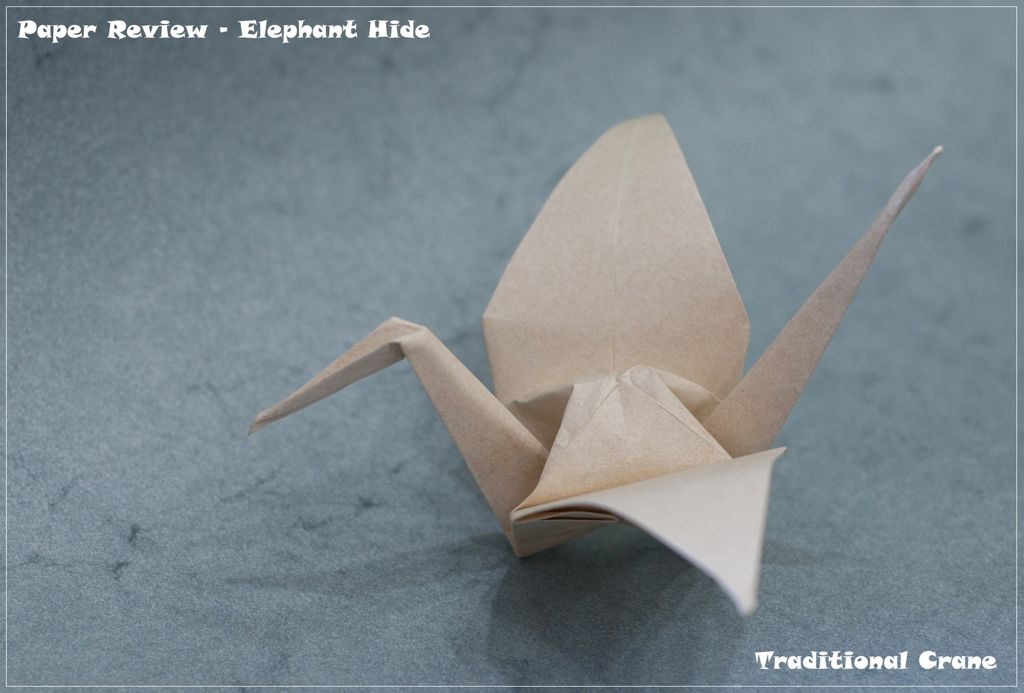
- Action model
- Barking Dog, by Gadi Vishne 15cm. This paper gave me the best result I (Gadi) ever got with this model. I refold it several times, gave it to my 4 years kid, and it still moves very easily. The only complaint against this paper is the colors. With this "both sides same color" paper, I had to paint the paper to get different color for the nose.

- Traditional Flapping Bird. I also tried the traditional flapping bird. It is the best paper for this model! It's easy to fold the bird and it will flap perfectly. Both wings move evenly, and there's no chance of tearing the lower part of the wings, especially in the first couple of strokes. The paper will not tear even if I pull it intensely.
- Traditional Jumping Frog, 15cm. I got the best results with the frog. I used a 15cm square and folded it in half. Then I folded a waterbomb base for the head. The Flex is amazing! I measured a few jumps, most are around 60 to 80cm and once I crossed the 1m mark!
- Barking Dog, by Gadi Vishne 15cm. This paper gave me the best result I (Gadi) ever got with this model. I refold it several times, gave it to my 4 years kid, and it still moves very easily. The only complaint against this paper is the colors. With this "both sides same color" paper, I had to paint the paper to get different color for the nose.
- Modular/Unit Origami
- PowerPuff modular, by Ilan Garibi, made from 30 14X14 cm units - having to cut these sheets by hand was a major drawback. I (Ilan) cut it to 14X14 to fit five units in the 70 cm length of the sheet. Folding 30 units with such heavy paper required very strong finger pressure, but the final result is superb. Friction is enough and the bending resistance is excellent, especially with the puffing part of the PowerPuff unit. The final model is very stable and strong. Note that this model's lock is not based on friction but on pressure.

- Icarus Cube by Dave Mitchell made from six 5x5 cm units that (Gadi) folded a few weeks ago. For this model, the paper is very smooth. The cube breaks into pieces too easily. A modular folded from this paper, must have a good lock between the units or a very tight pocket.

- PowerPuff modular, by Ilan Garibi, made from 30 14X14 cm units - having to cut these sheets by hand was a major drawback. I (Ilan) cut it to 14X14 to fit five units in the 70 cm length of the sheet. Folding 30 units with such heavy paper required very strong finger pressure, but the final result is superb. Friction is enough and the bending resistance is excellent, especially with the puffing part of the PowerPuff unit. The final model is very stable and strong. Note that this model's lock is not based on friction but on pressure.
- Tessellation - Pineapple and Mystery tessellations, by Ilan Garibi, from a 70X70 cm paper - this paper is made for tessellations. Folding the grid can be done very accurately, although the paper is a bit hard to fold perpendicular to the grain. Switching a fold is quite easy; I (Ilan) made my grid by matching every two adjacent creases to create the fold between them, which demands a lot of switching of folds. The paper tends to “break” on the right place with a bit of pressure. Pre-creasing is very clean as short fold lines do not affect the surrounding surface, so the final result is uncontaminated. Strength is another strong point: no tearing or weakened points, with no fibers showing in the corners. For the Mystery model (made in light brown), backlighting produced a great effect.

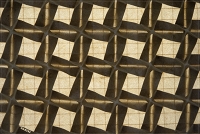
- Complex - Pegasus, by Satoshi Kamiya, from two different sizes of paper
- 35X35 cm - For pre-creasing, this paper was excellent; the final steps hardly folded. The final model was so wide that it couldn’t stand on three legs as it should. I (Gadi) put the poor Pegasus into a clamp for a night and closed it very tight. This paper is not able to be torn! After that night it could stand on three legs. Although the folds hold very well and the final model looks nice, I strongly recommend using thinner paper for complex models.
- 45X45 cm - being inexperienced with complex models, I (Ilan) happily choose the bigger size. Even so, it was a fight! The paper is too thick for this model, even at a size almost double than recommended. I could not fold the last steps, finalize the small details, or even bend the front leg, as done in step 92. The body turned out fat, maybe too fat, and some glue was needed to hold it together. Nevertheless, the final result is beautiful. The pegasus stands tall, wings held up high, in a majestic pose.

- 3D models - Rat by Joisel, 25X25 cm or Fox Terrier by Francisco Javier Caboblanco 20X20cm. The rat mixes straight lines with curved shaping. In this section the focus is on the three-dimensional curves. To shape the tail I (Gadi) tied it in a wet rag and let it dry curved. The result was a nice curved tail. The ears shaped easily by pinching them in the center. Here the strength of the paper was an advantage. It helped to make them rounded. For the Fox Terrier, I wet a 20cm square and got a change in the proportions of the square. Nevertheless the Terrier didn’t suffer too much. In the end, the model was nice and stable. The paper held the exact amount of water I needed. I didn’t have to re-wet the paper in the middle of the folding, nor did I need to wait for it to dry at the end.

Final verdict
What is it good for? For traditional use, it seems almost blasphemous. For tessellations it is no less than perfect, as is also the case for 3D models, wet folded or not. With complex models, you should not consider EH your first choice, but if you do, prepare for a struggle, with the possibility of an amazing end result. If you have the time and patience to hand cut your paper for Modular Origami, EH is great, being very strong and stable, but perhaps not for models that connect using friction! This paper is the best for action models; it is strong, holds creases nicely, and is not going to tear even in the hands of small children (as tested by Gadi’s four-year-old boy).
Beginner should not use this paper; it is too heavy.
Browsing through the Flickr search engine for EH images, the vast majority (90%) are tessellations. The other 10% are masks and 3D animals, mostly high to low intermediate level models (the most common one being, no surprise, an elephant!). Of the 749 images, there were less than ten images of complex models.
Bottom line - this paper is a must buy and a unique experience. Full satisfaction guarantee!
Our next review will present Tant paper. Still to come are Silk/Foil, wrapping paper (40 GSM) by Kraft, Onion Skin paper, Kami and more.
Please write your comments and feedback directly to the authors:
Ilan Garibi - garibiilan (at) gmail (dot) com
Gadi Vishne - gadi (at) vishne (dot) com
Special thanks to Herman Mariano for his colorability section.

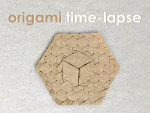
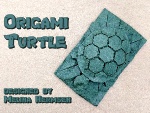
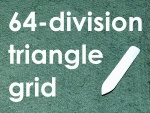
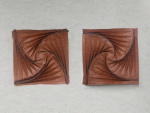
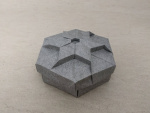
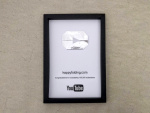
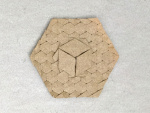
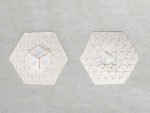
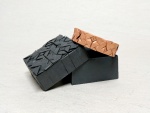
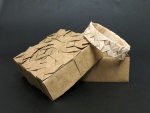
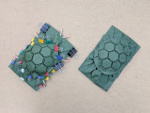
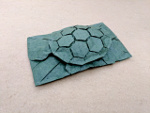
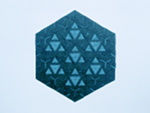
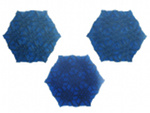
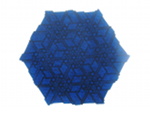
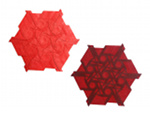
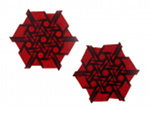
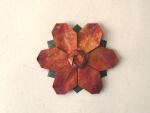
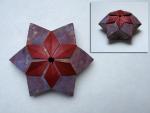
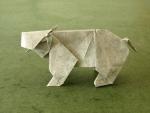
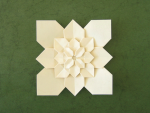
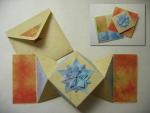
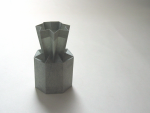
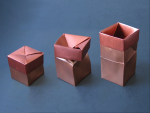
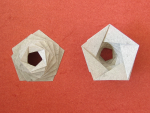
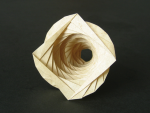
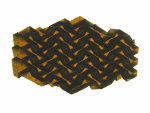
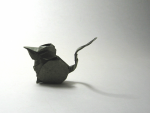
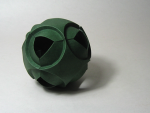
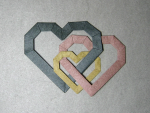
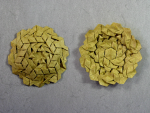
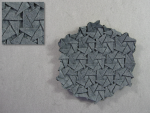
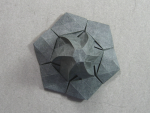
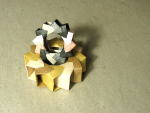
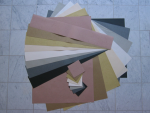
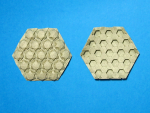
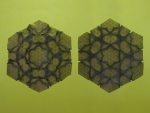
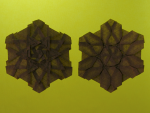
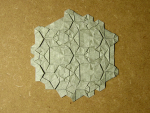
Comments
Submitted by Anonymous (not verified) on 8 December 2010 - 10:51pm Permalink
paper
Ive been making a lot of modular origami lately and when i look through all the books i have an on the internet at the best models out there, Ive found it hard to find multiple pieces of paper of the same color when i buy paper. For instance in Tomoko Fuse's book origami unit essence many of her large models require 90+ pieces of paper. my question is where do you buy your paper and where could i find many pieces of paper of the same colour in a pack? thanks
Submitted by Sara on 9 December 2010 - 8:37am Permalink
A couple of options
There are a couple of options:
* Many modulars look beautiful if you use different colors. Choosing colors that complement each other can be really fun, too.
* You can buy packs of origami paper that have all the same color. For example, I've recently been working with this paper: http://origamikaikan... 200 sheets, all the same color. Having said that, I did cut many of the sheets in half, and some in quarters. But it's better than cutting down from very large sheets. :)
* You can cut your squares yourself. Admittedly, if you need many sheets, having a cutting machine helps a lot, but I've done my share of cutting many sheets for modular origami. For example, I cut the paper for this model: http://www.happyfold... - it has 90 modules, too.
Hope this helps a bit,
-- Sara
Submitted by Anonymous (not verified) on 10 December 2010 - 10:30pm Permalink
thanks
Thank you very much Sara. il definitely take what you said into consideration when i buy paper.
Submitted by Anonymous (not verified) on 10 December 2010 - 10:39pm Permalink
curious
how did you manage to buy from that Japanese website? i cant read Japanese.
Submitted by Sara on 11 December 2010 - 3:30am Permalink
Not the only source
I didn't say I bought paper from that site, just that I've been working with that kind of paper. :) I bought it at the CDO convention this year, and they had a selection of Japanese paper, too.
-- Sara
Submitted by Anonymous (not verified) on 11 December 2010 - 10:18pm Permalink
clearing it up
ahh okay thank you very much. I have no idea where il find the paper but I will keep looking
Submitted by Anonymous (not verified) on 12 December 2010 - 9:37pm Permalink
You Convinced me to order
You Convinced me to order some elephant hide. Thanks! I really like these reviews on paper
Submitted by Anonymous (not verified) on 8 January 2011 - 3:34am Permalink
Drupal!
Hello, Sara! Sorry for interrupting this post with this comment, but I just wanted to put it where you could see it. Anyways, I checked out the source code of this site and saw you made it with Drupal. I was instantly inspired. At first, I had a lot of trouble installing Drupal, but I eventually figured it out. Really, I was at my wit's end trying to get it installed, ad just as I was going to come and ask you, L and behold, there was the installation screen at localhost:8888. So, what are some cool things you found with Drupal?
P.S. You are doing a phenomenal job with the site and the videos, I just love them.Keep up the incredible work!
-I0Met0Him/Phillip
Submitted by Anonymous (not verified) on 12 January 2011 - 7:25pm Permalink
Deliver in U.S
Do u know if Modulor delivers in the us? I'm only asking b/c i see that it has a bigger range of colors which i admire.If not,is there any other site that has a big range of colors?Please reply
Submitted by Sara on 16 January 2011 - 10:04pm Permalink
Check what their website says
Check http://www.modulor.d... - there they do say which restrictions apply for delivering worldwide (4. Worldwide shipping).
-- Sara
Submitted by Anonymous (not verified) on 21 January 2011 - 10:45am Permalink
hello . nice post . thanks .
hello .
nice post .
thanks .
Submitted by Anonymous (not verified) on 29 March 2011 - 7:40am Permalink
re
There is little point to reviewing Elephant Hide as applied to Miniature Unit Origami, or Foil to a wet fold. One should try to determine what a paper is good for, to be tessellated, or to fold insect models, for example.
Submitted by Sara on 29 March 2011 - 1:20pm Permalink
A matter of opinion
Actually, I think it's good that Ilan and Gadi are reviewing the paper for all kinds of applications. It does show what a paper is good for, but also show why it's not so good for other things. Sometimes we assume a paper won't work, but we never try - and when we do, we might realize that we had assumed incorrectly. Having a proof of concept is much more convincing to me.
Plus, Ilan and Gadi do highlight in the summary what they think the paper is best used for. So if you prefer not reading why a paper type is not good for x or y, simply read the conclusion first, and then only read the sections related to the recommendation. :)
-- Sara
Submitted by Anonymous (not verified) on 25 September 2011 - 6:07am Permalink
Just Bought
I just got my first 2 sheets of elephant hide!! I bought a yellow one and charcoal one from Kim's Crane. Just by feeling the paper I know it's going to be awesome for tessellations. I can't wait! Just thought I'd share :)
Submitted by Anonymous (not verified) on 12 January 2012 - 8:43pm Permalink
Out of Production?
Is there any word on the reported end of production of elephant hide by Zanders?
"firm which produce Elephant Hide paper stopped production. I'm buying all the few rest of stock available for world for you."
http://twitter.com/#...
Submitted by Anonymous (not verified) on 2 September 2012 - 7:31pm Permalink
elephant hide for sale
http://www.ebay.co.u...
This must be worth something to someone?
Submitted by Sara on 3 September 2012 - 10:41pm Permalink
190gsm
In most cases, 190gsm, Elephant Hide will be too heavy for origami.
-- Sara
Submitted by Anonymous (not verified) on 18 September 2012 - 6:16pm Permalink
really? i heard its really
really? i heard its really good for wet folding.. tempted to place a bid. cant find any of this paper in the UK!
Submitted by Anonymous (not verified) on 18 September 2012 - 6:19pm Permalink
190 gsm
what would you use 190gsm for ?
Submitted by Anonymous (not verified) on 18 September 2012 - 6:15pm Permalink
elephant hide for sale
Theres more, the last one sold for only £15.. Bargin!
http://www.ebay.co.u...
Submitted by Melissa (not verified) on 11 March 2019 - 12:45pm Permalink
Thank you so much!
I just wanted to say that I have spent many happy hours reading all these paper reviews and I was absolutely over the moon to find the listing for elephant hide in Singapore, which I immediately proceeded to visit and picked up some 50x70cm sheets for US$1 each! I will definitely plan to visit the warehouse for larger sheets next and this site has absolutely made my day!
Submitted by Melissa (not verified) on 12 March 2019 - 7:40am Permalink
Update on the Singapore Fancy Papers location
I went on a visit to the Fancy Papers warehouse today (yay!) and found they have moved to a different location from the one listed on this original post. Here's the new location for your readers so they don't end up wandering a random industrial estate like I did :D
Fancy Papers Supplier (warehouse location)
9 Playfair Rd, Singapore
Phone: 6748 1268
Open 830am-530pm
As of today's visit (Mar 2019), the price per 70x100cm elephant hide sheet is Singapore$2.25 per sheet plus 5% GST (US$1.8). They carry 4 colors in the 110gsm: buff, hi-white, white, and mouse grey and there's no minimum quantity
In their retail location, a sheet of 50x70cm is Singapore$1.5 plus tax (US$1.2) in the same 4 colors
Submitted by Sara on 28 March 2019 - 6:31am Permalink
Thanks!
Thanks, I've updated the article accordingly.
-- Sara